Wondering if the rowing machine is a good match for people with bad knees? Here is how to stay pain-free on the rowing machine, benefits, and more.
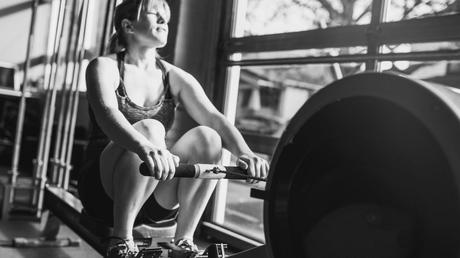
Knee problems can be a real issue when it comes time to exercise.
You can’t squat, lunge, or kick quite as efficiently as you used to, and you may find that every movement brings a bit of pain—not to mention the worry that your exercise will just make the existing injury worse.
It’s tough to find a workout that won’t exacerbate your pain, especially a cardio workout, thanks to the fact that most cardio machines focus heavily (or entirely) on your lower body.
But what about the rowing machine? Can it be a safe, effective choice for working out with bad knees?
That’s what we’re going to find out in this article.
Below, I’ll look at what makes the rowing machine not only a great cardio machine for weight loss, but also for knee injuries. I’ll also share some simple yet highly effective tips on how to use a rowing machine the smart, safe way to avoid and prevent rowing pain.
By the end of this page, you’ll be ready to get your sweat on knowing everything you can do to take your workout to the next level without hurting your knees.
Let’s jump right in.
Why the Rowing Machine is Good for People with Bad Knees
There are a lot of benefits of rowing machines—including a full body workout, great fat-burning, and the list goes on—but in this article, I want to focus on why the rowing machine is good specifically for people with bad knees.
 Joint support
Joint support

To start off with, some of the muscles worked on the rowing machine are the muscles that support your knee joint—specifically, the hamstring and quadriceps muscles.
Every time you row, you strengthen these muscles, which in turn makes them more effective at engaging when your legs need to work.
To put it simply, the stronger the muscles around the knees are, the more support the knees have during periods of high stress or tension.
Building muscle with a rowing machine—specifically, your leg muscles—is crucial for protecting your knees against injury in future resistance training, cardio workouts, and general activity.
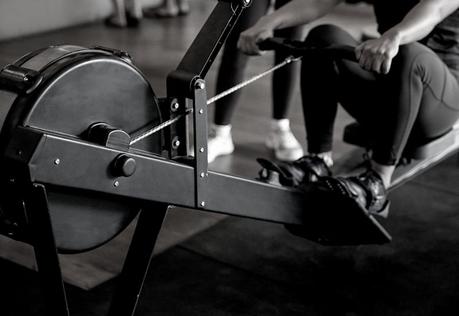
 Low impact
Low impact

Another great thing about the rowing machine is that it’s almost zero impact.
Some exercises, such as running, jumping, or playing sports, is high impact.
Your feet lift off the ground (in the case of jumping, both at the same time) and there is impact when they make contact with the ground again.
High impact exercise can take a toll on the tissue of your bones, muscles, and joints, wearing them down over time.
For people with existing knee pain or injuries, high-impact exercise can exacerbate your problems and increase pain, swelling, and stiffness.
The rowing machine, because your feet are planted and there are no “foot strikes,” remove impact altogether.
 Weight loss
Weight loss

Last, but definitely not least, rowing will be a great way to burn fat and lose weight.
The number of calories burned on the rowing machine will depend on a lot of factors—rowing speed, resistance setting, your metabolism, etc.—but suffice it to say, a good rowing workout will burn a lot of calories (upwards of 600 per hour).
The more calories you burn, the more weight you can lose. The more weight you lose, the lighter the load on your joints, bones, and muscles in your everyday life. Less load means a lower risk of joint problems.
This is one of the best benefits across the board—you’ll look better, feel better, and be fitter overall. However, it specifically benefits your joints, lessening the load and thereby decreasing the risk of injury and knee pain.
How to Avoid Knee Pain on the Rowing Machine
It’s actually fairly normal for beginners to feel some knee pain on the rowing machine. This is caused by a number of factors—including incorrect form and posture, limited mobility, insufficient leg strength, and more.
Thankfully, all these factors can be easily corrected. With a bit of practice, you can master the form and movement so you don’t experience any knee pain at all when training.
Here are some simple tips you’d do well to follow:
 Keep your knees tracking straight forward.
Keep your knees tracking straight forward.

Keeping your knees moving forward over your ankles and toes ensures that your legs are fully aligned and engaged correctly.
Letting your knees fall outward may reduce the strain on your hips and core, but that is incorrect posture and can lead to a higher risk of injuring your knees or exacerbating existing knee pain.
 Don’t slide too far forward.
Don’t slide too far forward.

One major (and very common) mistake is sliding too far forward, which causes you to bend your knees a bit too far. When this happens, you can pull on the joint tissue, causing microscopic damage that can swell up and cause pain.
Plus, your muscles will rub against the joints and bones, leading to inflammation and compromising muscle engagement.
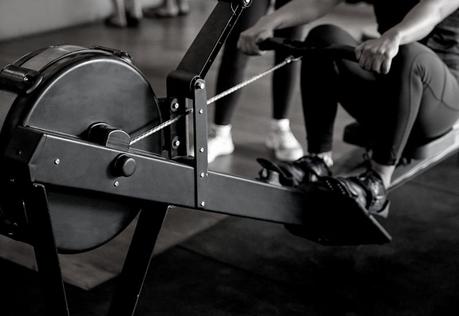
Instead, stop sliding forward when your shins are parallel to the floor. Your knees should never pass your ankles, but stop when your lower legs are vertical. That will keep your leg muscles engaging correctly and prevent over-extending the knee joints.
 Never lock out your knees.
Never lock out your knees.

Locking out your knees (also called hyper-extending) is a major no-no in literally every activity–be it running, jumping, lifting weights, or rowing.
When you lock out your knees, you actually disengage the muscles that are supporting your knee joints, placing all of the strain on your bones and joint tissue. Repeatedly doing this can lead to serious damage, as well as inflammation and swelling.
When you drive backward on the rowing machine, stop before your legs are locked out.
There should be just enough bend in your knees that your joints are supported and the muscles still engaged.
 Place your feet correctly.
Place your feet correctly.

If you find your knees tend to flare outward, it might be because your feet are placed too close together.
Widening the placement of your feet slightly can help to correct the engagement of your ankles, knees, hips, and lower back, making it easier on your joints and preventing joint pain.
 Don’t row every day.
Don’t row every day.

Overtraining and under recovery are among the most common causes of joint pain, including knee pain.
When you overtrain and don’t recover adequately (train too hard and/or too often), your body doesn’t have time to repair the microscopic damage that forms in your joint, muscle, and bone tissue.
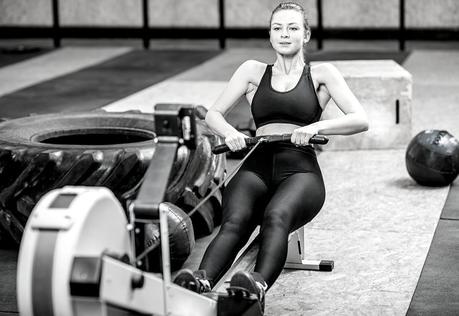
Over time, the damage compounds, until it is bad enough to cause pain, swelling, and other problems.
The harder and longer you row, the more time you need off between workouts.
Ideally, give yourself 48 hours between rowing sessions—especially HIIT/Tabata and endurance/long-distance rowing sessions—so your body has time to make the necessary repairs and restore your joints, bones, and muscles to full capacity before you challenge them again.
 Change up your shoes.
Change up your shoes.

There is such a thing as “indoor rowing shoes”, which are essentially shoes with a very flat, minimalist sole that won’t affect the way your feet rest on the pedals, allowing for proper knee placement.
If you’re going to row regularly—or you are working towards rowing professionally—they may be a good investment.
On the other hand, if you just want a good pair of shoes to use for rowing workouts, consider any lightweight, minimalist shoe, or anything that you’d use for leg workouts—for example, Chuck Taylors or barefoot runners.
These shoes will encourage optimum performance, help you to master the form and posture, and improve kinetics through the full rowing stroke.
 Strap in smart.
Strap in smart.

The foot strap should always run across the ball of your foot, just below your toes. Never strap your toes in, and definitely don’t strap in the bridge of your feet.
Adjust the pedal so your feet are properly strapped in before you start rowing. Incorrectly strapping in will make it more likely that you’ll twist your knee to compensate with every stroke, which in turn increases stress on both your knee and ankle joints.
 Warm-up and cool down.
Warm-up and cool down.

Never sit down and row hard from “cold”. You should always take the time to limber up your joints and muscles before any workout, and it’s even more important when you’re going to do a high-impact or high-intensity workout.
Spend 5 minutes stretching before you sit down on the rowing machine. Stretch out all the muscles you’ll be using during your training—your upper back and lower back, shoulders, biceps, forearms, abs, and legs—and pay extra attention the muscles around your knees (including the quads and hamstrings).
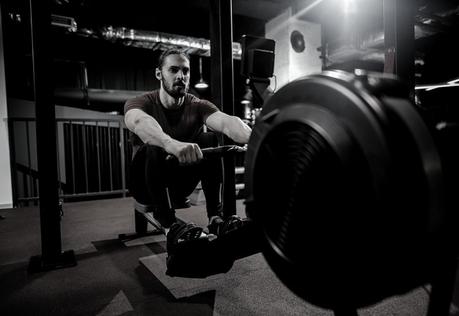
Then, when you sit down, spend another 5 minutes rowing at a slow pace to give your muscles time to loosen and warm up.
Finish your workout with another 5 minutes of slow-pace rowing to cool down, too. It’s the smart way to prevent injury and inflammation!
 Have ice or ice packs handy.
Have ice or ice packs handy.

After every workout, it’s worth icing your knee to deal with existing pain or prevent future injuries. Your knee joints and the muscles around your knees may be slightly inflamed due to repeated friction (rubbing against the bone).
Applying ice or an ice pack will stop inflammation from worsening, preventing pain and stiffness and enabling your body to repair the damage faster.
Other tools you can use for addressing inflammation and speeding up recovery include your trusty foam roller, an EMS machine, or simply spending some time stretching up and downstream from the knee.
The Rowing Machine and Knee Pain – FAQs
What other cardio machines are good for people with knee pain?
Anyone who is experiencing or concerned about knee pain should definitely spend time on the rowing machine, because it places no direct load on your knees and will be a low-impact form of training.
But it’s not the only machine in the gym worth using. You should also try the elliptical machine, which is also a fairly low-impact machine that will help you get in a highly effective calorie-burning workout without straining your knees.
Another great cardio machine for people with bad knees is the stationary bike.
Your legs are doing all the work, but supporting no direct load, and you can increase or decrease the resistance or stand up/sit down according to what feels right for your knees.
How often should people with knee pain use the rowing machine?
If you are currently experiencing knee pain, try to give yourself at least 48 hours between rowing machine workouts. That way, your knees have plenty of time to recover from the repeated friction of your workouts.
If you’re prone to knee injuries or pain but aren’t currently experiencing pain, you can try working out at least 24 hours apart.
Consider switching up the workouts, though, incorporating other cardio machines (like the treadmill, stair climber, elliptical, or stationary bike) to avoid putting your knee through the exact same movements every day.
The Bottom Line
Working out with knee pain is possible, and thanks to the rowing machine, it can even be done safely and effectively.
You will need to be more aware of your joints, how you’re using them, what sort of fatigue and strain they’re experiencing, and how they feel before, during, and after every workout.
However, thanks to the low-impact nature of the rowing machine, you’ll find it’s fairly easy to get through your training session without significant discomfort or inflammation.
It’s the best machine to use if you’re experiencing knee pain but still want to get in a truly effective calorie-burning workout.
More Rowing Machine Guides and Articles
5 Rowing Machine Workouts for Beginners (Plus Tips for Rowing Like a Pro). The rowing machine is the perfect low-impact and full-body cardio machine for beginners. Here are five rowing machine workouts for beginners and tips for doing them like a pro.
Are Elliptical Trainers Good for Bad Knees? (And How to Avoid Knee Pain on the Elliptical). Elliptical trainers are one of the best cardio machines for people with bad knees. Here is why the elliptical works for bad knees and how to avoid knee pain on the elliptical trainer.
